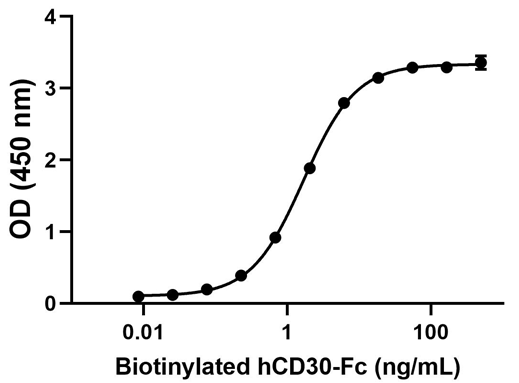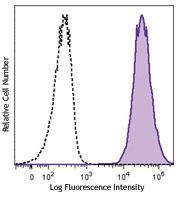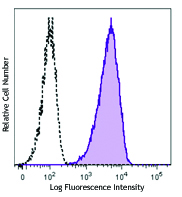- Regulatory Status
- RUO
- Other Names
- CD27 ligand, CD70, Ki-24 antigen, TNFSF7
- Ave. Rating
- Submit a Review
- Product Citations
- publications

-

Human CD27L binds to immobilized CD27 (2 µg/ml) in a dose dependent manner. The ED50 = 8 - 30 ng/ml.
| Cat # | Size | Price | Quantity Check Availability | Save | ||
|---|---|---|---|---|---|---|
| 553404 | 25 µg | £101 | ||||
CD27L is a 50 kD type II transmembrane glycoprotein and member of the tumor necrosis factor superfamily. Human CD27L and its mouse counterpart share about 56% sequence homology. The interaction of CD27L and CD27, a protein of the TNF receptor superfamily expressed on NK cells and subsets of T and B cells, provides co-stimulatory signals that are required for T cell proliferation, clonal expansion and development of effector T cells. CD27L-CD27 interaction on mouse B cells, on the other hand, has been shown to inhibit terminal differentiation of B cells into plasma cells. CD27L expression in mice is induced by B cell receptor activation in B cells, and at low levels by T cell receptor activation in T cells. CD27 interaction with recombinant soluble CD27L protein (sCD27L), showed that sCD27L enhanced IFN-γ secretion by CD56 (bright) NK cells in the presence of IL-12, and these NK cells were able to suppress HCV replication. Also, CD8+ T cells stimulated with sCD27L in the presence of antigen (Ag) showed enhanced proliferation and production of IL-2 and IFN-γ in vitro. In addition, administration of Ag and sCD27L induced expansion of Ag-specific CD8+ T cells in vivo. Data suggestes that sCD27L is a potent stimulator of antiglioma immune responses that depend on CD8+ T cells; therefore, sCD27L might be a good candidate as adjuvant in immunotherapy trials for glioblastoma.
Product DetailsProduct Details
- Source
- Human CD27L, amino acids (Gln39-Pro193) (Accession# NP_001243.1), was expressed in CHO cells with a N-terminal 9His tag and a linker sequence.
- Molecular Mass
- The 176 amino acid recombinant protein has a predicted molecular mass of approximately 19.3 kD. The protein migrates at about 35 kD in DTT-reducing conditions by SDS-PAGE. The predicted N-terminal amino acid is His.
- Purity
- >90%, as determined by Coomassie stained SDS-PAGE.
- Formulation
- 0.22 µm filtered protein solution is in PBS.
- Storage & Handling
- Unopened vial can be stored between 2°C and 8°C for up to 2 weeks, at -20°C for up to six months, or at -70°C or colder until the expiration date. For maximum results, quick spin vial prior to opening. The protein can be aliquoted and stored at -20°C or colder. Stock solutions can also be prepared at 50 - 100 µg/mL in appropriate sterile buffer, carrier protein such as 0.2 - 1% BSA or HSA can be added when preparing the stock solution. Aliquots can be stored between 2°C and 8°C for up to one week and stored at -20°C or colder for up to 3 months. Avoid repeated freeze/thaw cycles.
- Activity
- Human CD27L binds to immobilized CD27 (2 µg/ml) in a dose dependent manner. The ED50 = 8 - 30 ng/ml.
- Application
-
Bioassay
- Application Notes
-
BioLegend carrier-free recombinant proteins provided in liquid format are shipped on blue-ice. Our comparison testing data indicates that when handled and stored as recommended, the liquid format has equal or better stability and shelf-life compared to commercially available lyophilized proteins after reconstitution. Our liquid proteins are verified in-house to maintain activity after shipping on blue ice and are backed by our 100% satisfaction guarantee. If you have any concerns, contact us at tech@biolegend.com.
Antigen Details
- Structure
- Homotrimer
- Distribution
-
Activated T cells, B cells, NK cells, antigen presenting cells, activated plasmacytoid dendritic cells, chronic B cell lymphocytic leukemia, and large B cell lymphomas.
- Function
- Role in T cell proliferation, generation of cytolytic and memory T cells, B cell proliferation and differentiation. CD27L is induced by B cell receptor activation in B cells and downregulated by interaction with its receptor CD27.
- Ligand/Receptor
- CD27
- Bioactivity
- Human CD27L induces proliferation of PHA-activated T cells.
- Biology Area
- Cancer Biomarkers, Cell Proliferation and Viability, Immunology
- Molecular Family
- Cytokines/Chemokines, Growth Factors, Immune Checkpoint Receptors, Soluble Receptors
- Antigen References
-
1. Bowman MR, et al. 1994. J. Immunol. 152:1756.
2. Shaw J, et al. 2010. Blood. 115:3051.
3. Keller AM, et al. 2009. Blood. 113:5167.
4. Tesselaar K, et al. 1997. J. Immunol. 159:4959.
5. Akiba H, et al. 1999. J. Immunol. 162:7058.
6. Miller J, et al. 2010. J. Neurosurg. 113:280.
7. Kuka M, et al. 2013. J. Immunol. 191:2282.
8. Jang YS, et al. 2013. Clin. Immunol. 149:379.
9. Yoshino K, et al. 2013. Br. J. Haematol. 160:331. - Gene ID
- 970 View all products for this Gene ID
- UniProt
- View information about CD27L on UniProt.org
Related FAQs
- Why choose BioLegend recombinant proteins?
-
• Each lot of product is quality-tested for bioactivity as indicated on the data sheet.
• Greater than 95% Purity or higher, tested on every lot of product.
• 100% Satisfaction Guarantee for quality performance, stability, and consistency.
• Ready-to-use liquid format saves time and reduces challenges associated with reconstitution.
• Bulk and customization available. Contact us.
• Learn more about our Recombinant Proteins. - How does the activity of your recombinant proteins compare to competitors?
-
We quality control each and every lot of recombinant protein. Not only do we check its bioactivity, but we also compare it against other commercially available recombinant proteins. We make sure each recombinant protein’s activity is at least as good as or better than the competition’s. In order to provide you with the best possible product, we ensure that our testing process is rigorous and thorough. If you’re curious and eager to make the switch to BioLegend recombinants, contact your sales representative today!
- What is the specific activity or ED50 of my recombinant protein?
-
The specific activity range of the protein is indicated on the product datasheets. Because the exact activity values on a per unit basis can largely fluctuate depending on a number of factors, including the nature of the assay, cell density, age of cells/passage number, culture media used, and end user technique, the specific activity is best defined as a range and we guarantee the specific activity of all our lots will be within the range indicated on the datasheet. Please note this only applies to recombinants labeled for use in bioassays. ELISA standard recombinant proteins are not recommended for bioassay usage as they are not tested for these applications.
- Have your recombinants been tested for stability?
-
Our testing shows that the recombinant proteins are able to withstand room temperature for a week without losing activity. In addition the recombinant proteins were also found to withstand four cycles of freeze and thaw without losing activity.
- Does specific activity of a recombinant protein vary between lots?
-
Specific activity will vary for each lot and for the type of experiment that is done to validate it, but all passed lots will have activity within the established ED50 range for the product and we guarantee that our products will have lot-to-lot consistency. Please conduct an experiment-specific validation to find the optimal ED50 for your system.
- How do you convert activity as an ED50 in ng/ml to a specific activity in Units/mg?
-
Use formula Specific activity (Units/mg) = 10^6/ ED50 (ng/mL)
 Login / Register
Login / Register 















Follow Us